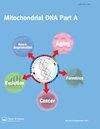一个群落海鞘的DNA条形码,Lissoclinum fragile (Van Name, 1902)
IF 0.6
4区 生物学
Q4 GENETICS & HEREDITY
引用次数: 3
摘要
摘要海鞘是一种具有抗氧化、抗肿瘤、抗菌等多种药理活性的海洋底栖生物。它们也是研究各种神经行为障碍的模式生物。据报道,由于缺乏分类学家以及基于形态学的分类限制,印度海鞘的多样性较少。分子分类学,包括细胞色素c氧化酶1基因(条形码区域)的测序,也称为DNA条形码,减少了这些瓶颈。由于Didemnidae科的几个物种在形态上非常相似,本研究旨在建立属于Didemnidae科的一群海鞘,Lissoclinum fragile的DNA条形码。对来自Thoothukudi、Mandapam和Vizhinjam水域的L. fragile的CO1基因进行测序,并通过条形码提交工具提交到GenBank, NCBI中。BLAST结果表明,不同站点采集的易碎菌的同源性最高(97 ~ 100%)。采用木村二参数法(K2P)计算种内和属内的成对遗传距离,并采用邻居连接树(neighbor - joining tree)构建系统发育树。本文章由计算机程序翻译,如有差异,请以英文原文为准。
DNA barcoding of a colonial ascidian, Lissoclinum fragile (Van Name, 1902)
Abstract Ascidians (tunicates) are marine benthic organisms possessing various pharmacological activities, including anti-oxidant, anti-tumour, antimicrobial, etc. They also play a key role as model organisms to study various neurobehavioral disorders. Ascidian diversity is reportedly less in India due to lack of taxonomists as well as the limitations in morphology based taxonomy. Molecular taxonomy, comprising the sequencing of cytochrome c oxidase 1 gene (barcode region) otherwise known as DNA barcoding reduces these bottlenecks. Since several species of the family Didemnidae closely resemble in morphology, the present study was aimed to develop DNA barcodes of a colonial ascidian, Lissoclinum fragile belonging to the family Didemnidae. CO1 gene of L. fragile from Thoothukudi, Mandapam, and Vizhinjam waters were sequenced and submitted in GenBank, NCBI through Barcode submission tool. BLAST results showed maximum identity (97–100%) for L. fragile collected from different stations. The pairwise genetic distances within species and genera were calculated using Kimura two parameter (K2P) and the phylogenetic tree was constructed using Neighbour-Joining Tree.
求助全文
通过发布文献求助,成功后即可免费获取论文全文。
去求助
来源期刊

Mitochondrial Dna Part a
Biochemistry, Genetics and Molecular Biology-Genetics
CiteScore
3.00
自引率
0.00%
发文量
6
期刊介绍:
Mitochondrial DNA Part A publishes original high-quality manuscripts on physical, chemical, and biochemical aspects of mtDNA and proteins involved in mtDNA metabolism, and/or interactions. Manuscripts on cytosolic and extracellular mtDNA, and on dysfunction caused by alterations in mtDNA integrity as well as methodological papers detailing novel approaches for mtDNA manipulation in vitro and in vivo are welcome. Descriptive papers on DNA sequences from mitochondrial genomes, and also analytical papers in the areas of population genetics, phylogenetics and human evolution that use mitochondrial DNA as a source of evidence for studies will be considered for publication. The Journal also considers manuscripts that examine population genetic and systematic theory that specifically address the use of mitochondrial DNA sequences, as well as papers that discuss the utility of mitochondrial DNA information in medical studies and in human evolutionary biology.
 求助内容:
求助内容: 应助结果提醒方式:
应助结果提醒方式:


